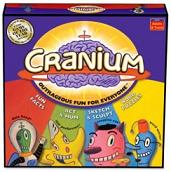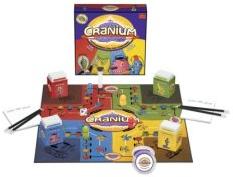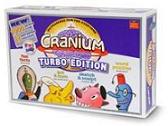
 [Cross-posted at my epinions account.]
[Cross-posted at my epinions account.]
We have friends over fairly often, and the game of Cranium is definitely one of our favorites to bring out. The game is terrific because it relies on teamwork and a variety of creative and intellectual tasks.
is definitely one of our favorites to bring out. The game is terrific because it relies on teamwork and a variety of creative and intellectual tasks.
This is no “Candy Land “; if you want to win, you’re going to have to use your… cranium, as it were. You can get the basic board rules from the game’s instructions; the more important information you need to know is about the different tasks you could be assigned.
“; if you want to win, you’re going to have to use your… cranium, as it were. You can get the basic board rules from the game’s instructions; the more important information you need to know is about the different tasks you could be assigned.
The Basic Stuff
Each space on the Cranium game board is marked with a color, either red, blue, green or yellow. At the four “corners” of the gameboard (actually located in the middle of each side) is a purple “brain.”. Regardless of how many spaces a player is supposed to move, they must stop when they reach each brain, even if their roll would have taken them further. Between each “brain” spot is an inside track and an outside track; the inside track has fewer spaces, so you get to the next brain more quickly. The team that goes first is the team including the player with the next birthday. I’m not kidding; this is in the rules!
game board is marked with a color, either red, blue, green or yellow. At the four “corners” of the gameboard (actually located in the middle of each side) is a purple “brain.”. Regardless of how many spaces a player is supposed to move, they must stop when they reach each brain, even if their roll would have taken them further. Between each “brain” spot is an inside track and an outside track; the inside track has fewer spaces, so you get to the next brain more quickly. The team that goes first is the team including the player with the next birthday. I’m not kidding; this is in the rules!


At the start of the game, every player is on the initial “brain” spot, and therefore they get to pick their first task. If they are successful in their first task, they get to roll the dice and move to the appropriate color via the inside track, and on their next turn, they will draw a card from the deck of this color. If they do not succeed in their first task, their turn is over. When they do successfully complete a task, they must go along the outside track until they reach the next brain. The inside-outside path resets at each brain, so you can still catch up even if you miss your first challenge.
Once you’ve made your way around the board, you enter the center “brain” – the big brain, if you will, and you must answer, on each of your subsequent turns, a question from each of the four categories. Once you finish the fourth, you move to the middle of the brain, and on your next turn, all of the other teams get to pick a card for you. That’s all of the teams, not each of the teams. They will have to agree on a category. Usually this category is red (Data Head), unless your team includes one of those people who just knows everything about everything. In order to win, your team must successfully complete this last task.
So What Are These Challenges?
The game’s challenges are broken up into four key categories: Word Worm (yellow), Creative Cat (blue), Data Head (red), and Star Performer (green).
Yellow is “Word Worm,” and contains such wacky tasks as:
- Gnilleps: One player from the team must correctly spell a word backwards on your first attempt, and without writing anything down.
- Spellbound: The same as Gnilleps, only you get to spell it the normal way!
- Zelpuz: The team must unscramble words using a very vague clue.
- Lexicon: Multiple choice definitions. Be careful – these aren’t SAT questions. Here, they ARE trying to trick you; watch out for homonyms, because inevitably both words’ definitions will be potential answers
- Blankout: These are the hardest; you must complete a word with letters whited out. You do get a clue, but the clues usually aren’t too helpful.
Green, “Star Performer,” is my favorite; it involves various physical performance skills, including:
- Humdinger: One team member must hum the song on the card, while the other members attempt to guess the song. Generally when we play, we allow the team member to hand over the card to another teammate if she doesn’t know the song; she is forbidden to guess. If no player knows the song, then we allow them to pick another card.
- Cameo: Basically, charades. In theory, you’re not supposed to be allowed to give any indication of how many words or whether your team is on the right track, but we generally just follow the rules of charades instead.
- Copycat: The performing team member must get her teammates to guess which famous person she is imitating by mimicking the person’s speech, actions, characteristics. No names of people or places are permitted, and the team member cannot respond to anything the guessers ask. This challenge can either be really boring or absolutely hilarious, depending on how strictly you adhere to the rules. Given “Elvis Presley,” some people will say something boring like, “I have left the building,” or “Thank you very much.” More creative performances will involve hip thrusting and curled lips. It’s up to the game’s players to decide what they will and will not allow here.
Blue, “Creative Cat,” is my other favorite; it involves artistic tasks such as:
- Cloodle: Basically, Pictionary.
- Sensosketch: Like Cloodle, except that the drawer’s eyes must be shut. This can be extremely entertaining, and I like to hold on to the most brilliant “Cloodle” masterpieces for reminiscing in future games. If you do this, you might want to label it after the turn is over; some of them will be pretty unrecognizable later on!
- Sculptorades: The player has to translate the answer into sculpted form. No gestures/acting/pointing is allowed; this isn’t charades!
Red, “Data Head,” is my least favorite, although some people are freakishly good at this. The tasks include:
- Factoid: Random trivia questions. No list to choose from. These can be ridiculously hard.
- Selectaquest: Trivia, but with multiple choice answers.
- Polygraph: True or false trivia. The logical answer is rarely the actual answer.
Things You Should Know
 If you seem to always guess correctly as to how sports games, current events, and other occurrences will turn out, perhaps you need to sign up for Predictify.
If you seem to always guess correctly as to how sports games, current events, and other occurrences will turn out, perhaps you need to sign up for Predictify. : The Movie gross in the box office on its opening weekend?” or “Who will be the Democratic candidate
for the 2008 presidential election?”





